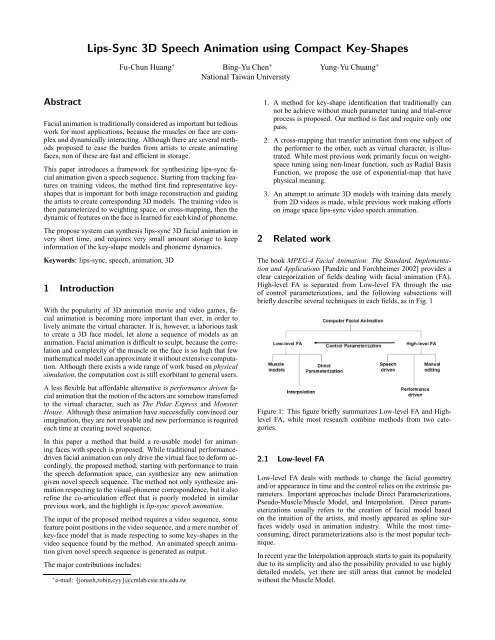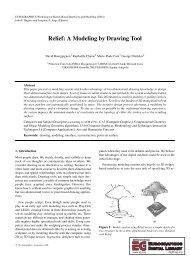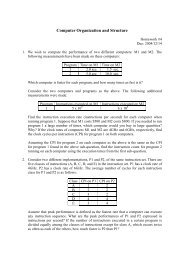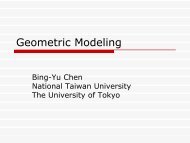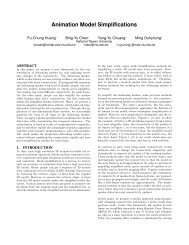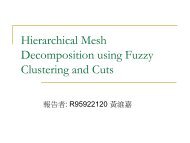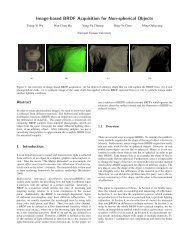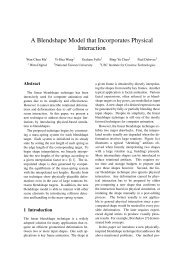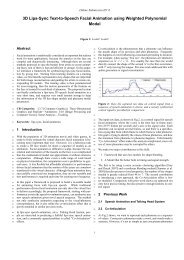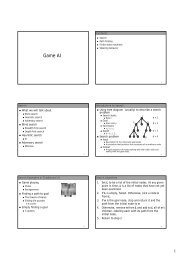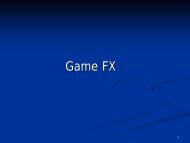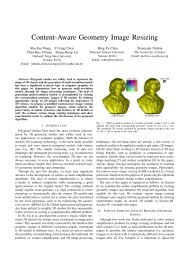Lips-Sync 3D Speech Animation using Compact Key-Shapes
Lips-Sync 3D Speech Animation using Compact Key-Shapes
Lips-Sync 3D Speech Animation using Compact Key-Shapes
Create successful ePaper yourself
Turn your PDF publications into a flip-book with our unique Google optimized e-Paper software.
<strong>Lips</strong>-<strong>Sync</strong> <strong>3D</strong> <strong>Speech</strong> <strong>Animation</strong> <strong>using</strong> <strong>Compact</strong> <strong>Key</strong>-<strong>Shapes</strong>Fu-Chun Huang ∗Bing-Yu Chen ∗National Taiwan UniversityYung-Yu Chuang ∗AbstractFacial animation is traditionally considered as important but tediouswork for most applications, because the muscles on face are complexand dynamically interacting. Although there are several methodsproposed to ease the burden from artists to create animatingfaces, non of these are fast and efficient in storage.This paper introduces a framework for synthesizing lips-sync facialanimation given a speech sequence. Starting from tracking featureson training videos, the method first find representative keyshapesthat is important for both image reconstruction and guidingthe artists to create corresponding <strong>3D</strong> models. The training video isthen parameterized to weighting space, or cross-mapping, then thedynamic of features on the face is learned for each kind of phoneme.The propose system can synthesis lips-sync <strong>3D</strong> facial animation invery short time, and requires very small amount storage to keepinformation of the key-shape models and phoneme dynamics.<strong>Key</strong>words: lips-sync, speech, animation, <strong>3D</strong>1 IntroductionWith the popularity of <strong>3D</strong> animation movie and video games, facialanimation is becoming more important than ever, in order tolively animate the virtual character. It is, however, a laborious taskto create a <strong>3D</strong> face model, let alone a sequence of models as ananimation. Facial animation is difficult to sculpt, because the correlationand complexity of the muscle on the face is so high that fewmathematical model can approximate it without extensive computation.Although there exists a wide range of work based on physicalsimulation, the computation cost is still exorbitant to general users.A less flexible but affordable alternative is performance driven facialanimation that the motion of the actors are somehow transferredto the virtual character, such as The Polar Express and MonsterHouse. Although these animation have successfully convinced ourimagination, they are not reusable and new performance is requiredeach time at creating novel sequence.In this paper a method that build a re-usable model for animatingfaces with speech is proposed. While traditional performancedrivenfacial animation can only drive the virtual face to deform accordingly,the proposed method, starting with performance to trainthe speech deformation space, can synthesize any new animationgiven novel speech sequence. The method not only synthesize animationrespecting to the visual-phoneme correspondence, but it alsorefine the co-articulation effect that is poorly modeled in similarprevious work, and the highlight is lip-sync speech animation.The input of the proposed method requires a video sequence, somefeature point positions in the video sequence, and a mere number ofkey-face model that is made respecting to some key-shapes in thevideo sequence found by the method. An animated speech animationgiven novel speech sequence is generated as output.The major contributions includes:∗ e-mail: {jonash,robin,cyy}@cmlab.csie.ntu.edu.tw1. A method for key-shape identification that traditionally cannot be achieve without much parameter tuning and trial-errorprocess is proposed. Our method is fast and require only onepass.2. A cross-mapping that transfer animation from one subject ofthe performer to the other, such as virtual character, is illustrated.While most previous work primarily focus on weightspacetuning <strong>using</strong> non-linear function, such as Radial BasisFunction, we propose the use of exponential-map that havephysical meaning.3. An attempt to animate <strong>3D</strong> models with training data merelyfrom 2D videos is made, while previous work making effortson image space lips-sync video speech animation.2 Related workThe book MPEG-4 Facial <strong>Animation</strong>: The Standard, Implementationand Applications [Pandzic and Forchheimer 2002] provides aclear categorization of fields dealing with facial animation (FA).High-level FA is separated from Low-level FA through the useof control parameterizations, and the following subsections willbriefly describe several techniques in each fields, as in Fig. 1Figure 1: This figure briefly summarizes Low-level FA and HighlevelFA, while most research combine methods from two categories.2.1 Low-level FALow-level FA deals with methods to change the facial geometryand/or appearance in time and the control relies on the extrinsic parameters.Important approaches include Direct Parameterizations,Pseudo-Muscle/Muscle Model, and Interpolation. Direct parameterizationsusually refers to the creation of facial model basedon the intuition of the artists, and mostly appeared as spline surfaceswidely used in animation industry. While the most timeconsuming,direct parameterizations also is the most popular technique.In recent year the Interpolation approach starts to gain its popularitydue to its simplicity and also the possibility provided to use highlydetailed models, yet there are still areas that cannot be modeledwithout the Muscle Model.
2.1.1 Muscle based approachesMuscle based approaches strive to mimic the minutia on facethrough bio-chemical and anatomic details. Choe et al.[Choe et al.2001] uses two kinds of muscle with finite element method to learnthe captured motion signal. A significant effort is devoted to establishthe relationship between muscle actuation and surface deformation.Their heuristic approach, however, lacks anatomical structureand need additional effort to adjust correlation near the mouth.More recently, Sifakis et al.[Sifakis et al. 2005] propose an anatomicalaccurate approach to analyze the signals of muscle activationwhich correspond to the sparse landmark on the face. Althoughtheir result is particularly useful in physical simulation, as illustratedin the paper from Sifakis et al.[Eftychios Sifakis and Fedkiw2006], the speed of this sort is prohibitive unaffordable when timeis a major concern.2.1.2 Interpolation based approachesInterpolation based approach poses another advantage over that ofmuscle based: simplicity and efficiency. Even the amount of blendshapemight be huge (more than hundreds of shape were used in TheLord of the Rings for the Gollum creature), the Interpolation basedcommunity still gains its popularity. The Facial Action Coding System(FACS) by Ekman and Friesen[Ekman and Friesen 1977] providea guideline for sculpting the blend-shape, where 72 ActionUnits of distinct expressive faces are categorized, and this techniqueis also used in the film industry, for example Monster House.Among the several methods <strong>using</strong> Interpolation approach, there canstill be a fundamental distinction between image-based and modelbased.Image-based FA has the advantage in data acquisition as opposedto that of <strong>3D</strong>-Model based, and the algorithm work efficiently whenprojected to the PCA space. Ezzat et al.[Ezzat et al. 2002] showhow to reanimate a person by decomposing video sequence intokey-shape space, and propose a Gaussian-Phoneme Model to synthesizenew speech animation <strong>using</strong> Multidimensional MorphableModels(MMM) by Jones and Poggio[Jones and Poggio 1998].Their work is extended by Chang and Ezzat[Chang and Ezzat 2005]to transfer model to different faces with existing trained model.Buck et al. [Buck et al. 2000] also shows how to blend sampleshapes for hand-drawn animation with parameterizations <strong>using</strong> Delaunaytriangulation in the feature space.Model-based FA include work by Chai et al.[xiang Chai et al.2003], Guenter et al.[Guenter et al. 1998], and Pighin et al.[Pighinet al. 1998], and etc,. PCA based method by Blanz and Vetter[Blanzand Vetter 1999] extends MMM[Jones and Poggio 1998] to <strong>3D</strong>model <strong>using</strong> morphable model database with feature-controls, andtheir method is able to reconstruct and animate photograph. Zhanget al.[Zhang et al. 2004] propose a FaceIK framework with blendshapescanned from their space-time stereo approach. They alsointroduce adaptive face segmentation to reduce interference fromunimportant blend-shapes. In order to reduce the blend-shape interference,Lewis et al.[Lewis et al. 2005] minimize the error incurredby selected control vertices with user controllable scaling factor.2.2 High-level FAHigh-level FA controls the parameters derived from Low-level FAmodeler to direct the face motion. The most precise but also themost time-consuming is manual editing, with artists introduce numerouskey-frames to capture the non-linearity on facial motion. Toreduce cost incurred from labor, two mainstreams are Performancedrivenand <strong>Speech</strong>-driven approaches.2.2.1 <strong>Speech</strong>-driven<strong>Speech</strong>-driven approach has its advocates because the fact that theyare mostly generative model, i.e. animators can generate new FAwithout tedious parameterizations from motion capture.Papers by Bregler et al.[Bregler et al. 1997] and Brand[Brand 1999]are two important precursors in this field. Ezzat et al.[Ezzat et al.2002] build a Gaussian based phoneme model and synthesize animationgiven phoneme aligned speech. The result of previouslybuilt model can be transferred to a novel person with a short trainingclip and synchronized speech as described in the paper by Changand Ezzat[Chang and Ezzat 2005]. The original model parametersare adjusted in accordance with the novel video corpus.Cao et al.[Cao et al. 2004] propose a fast searching algorithm intheir motion database for synthesizing new animating facial sequence.The eFASE system by Deng and Neumann[Deng and Neumann2006] also synthesizes new faces from recorded motion indatabase, and a path searching algorithm in the phoneme space <strong>using</strong>Isomap projection is proposed.2.2.2 Performance-drivenPerformance-driven approaches usually starts with a motion captureprocess. The signals of captured data are transferred as controlsfor reanimating FA with a cross-mapping function. Finally thecross-mapped signals are sent to Low-level FA modeler as rigs tomodify geometry data. Among the many performance driven approaches,the issue of cross-mapping is usually at heart to solve.Williams ”Performance-Driven Facial <strong>Animation</strong>”[Williams 1990]is the very first research in this field. In the course note[Pighin andLewis 2006], several survey of techniques for cross-mapping functionare presented. The simplest function form is linear as in thereport by Chuang and Bregler[Chuang and Bregler 2002]. Vlasicet al. [Vlasic et al. 2005] use multi-linear, or tensor, model to constructa statistical model for human faces, the dimension can beidentity, expression, viseme, and etc,. The cross-mapping is donewith motion capture from one identity and transfer to another withinframework.Choe et al.[Choe et al. 2001] build the inverse relationship withradial basis function (RBF), and also Pyun et al.[Pyun et al. 2003],Na and Jung[Na and Jung 2004], and Deng et al.[Deng et al. 2006],by estimating muscle actuation profile from the performance, sothat performance signal can directly be translated as the simulationparameters.An interesting technique proposed by Buck et al.[Buck et al. 2000]to transfer expression from performer to an NPR character. Theyproject the expression space on to the first two principal component,where Delaunay triangulation is subsequently applied. Whenevera new novel face is to be estimated, barycentric coordinate to itsnearest three key-shapes is calculated. This coordinate is afterwardtranslated to blending weights.2.2.3 Geometry TransferExpression Cloning by Noh and Neumann[Noh and Neumann2001] and Deformation Transfer for Triangle Meshes by Sumner
and Popović[Sumner and Popović 2004] are two papers that use directgeometry transfer function rather than parameterizing the transferfunction. Noh and Neumann[Noh and Neumann 2001] estimatethe local geometry property and transfers the motion vector to thetarget mesh with constraints that respect the locally defined boxes inthe two models. Sumner and Popović[Sumner and Popović 2004]extract the local gradient from the source and estimate similar gradienton the target mesh. Local misalignment of the triangle gradientis solved <strong>using</strong> global optimization framework with vertex connectivityas constraint, small imperfection on the mesh can, however,amplified, as noted in the course note[Pighin and Lewis 2006].2.3 SummaryIn this paper, a framework incorporating Interpolation and <strong>Speech</strong>-Driven animation is presented. The technique used in Interpolationwill be presented in Section 3, where a brief discussion onlinear/non-linear function will be given. As for high-level facialanimation, the statistical analysis for speech and its correspondingkey-frames will be studied in Section 5. Before the analysis, somepreprocessing issue will be discussed in Section 4.3 Preliminary3.1 <strong>Animation</strong> Reconstruction from Scattered DataObservationOne key process, to drive the <strong>3D</strong> model animate, is to control the <strong>3D</strong>model with certain given constraints. In light of cost/convinences,constraints may be sparse but should be representative enough forsurface reconstruction. One popular solution is Radial Basis Function(RBF),where intended values are interpolated from kernelconvoluteddistances to scattered observation. The problem of animationreconstruction could, however, be relaxed in a way whenwe already know some configuration of the surface. PCA basedtechniques have been proposed to drive <strong>3D</strong> model, yet numerousaligned examples have to trained in advance. (try to cite SCA 2006by UW, and SCAPE) Example-based model interpolation providean alternative without extensive preprocessing. Throughout this paper,we will always focus on processing triangle mesh.An explicit way to represent triangle mesh is with the coordinatesof its vertices in the global frame, and to reconstruct model surface,we can transform the problem into minimization, given K examplemeshes {P 1 ,...,P K }:α = argmin α∗1 ,...,α ∗ k ‖C − K∑i=1X i α i ‖where C is the constrained vertices position, X i ∈ P i is the constrainedvertices position in example mesh, and α is the intendedweights to blend these example meshes as reconstructed mesh.Problem with such approach is its lack of capturing local shapeproperty and relation, and when interpolating extreme poses, discontinuityin surface will occur due to the global frame positionmisalignment, and sample result is shown in Fig. 2 middle. Whilelinear-interpolation works well with very dense examples, it usuallyincrease the complexity and cost to acquire these models.To describe mesh better, it is suitable to represent mesh as a vectorin another feature space based oh their local shape property. Weuse deformation gradient, as the paper by Barr[Barr 1984] but in adiscrete form, to represent triangle mesh.Figure 2: Left: Original model to be approximated. Middle: Interpolatedmodel <strong>using</strong> global frame without local-shape-preservation.Right: Non-linear interpolated model solved with Eq. 23.2 Deformation GradientGiven a mesh in reference pose P 0 and a deformed mesh P, bothhaving n vertices and m triangles in identical connectivity structure,a deformation gradient is the Jacobian of the affine transformation,from a triangle in P 0 to P.Denote the affine transformation Φ j of the triangle τ j to map pointsit is defined v j k ∈ τ j ,k = 1,2,3 as:Φ j (v j k ) = T j v j k +t jT j is the rotation/scale/skew component and t j is the translation.Taking Jacobian of Φ j with respect to v j results in T j alone. the featurevector F i of the mesh P i is constructed by concatenating Jacobianof each triangles in a column form. Getting position back fromfeature vector consisting only Jacobian is done through integration,as described by Barr[Barr 1984], or by Sumner et al.[Sumner andPopović 2004] for discrete form. In computation, the discrete formis as describe as:V = argmin v ∗‖Gv − F‖where G is built from the reference pose P 0 and v is the verticespostilion we want to recover from feature vector F.Using deformation gradient, F i for example P i , as mesh descriptorfor animation reconstruction given constraints, we can formulatethe problem mathematically as :α = argmin α∗1 ,...,α ∗ k ‖Gv − K∑i=1F i ∗ α i ‖and the minimization is subject to X ∈ v be equal to constraints C.Although this description of mesh can preserve local shape property,artifacts can still appear at interpolating two surfaces with largedeviation in orientation where no intermediate examples are available.Non-linear interpolation, specifically exponential-map or logmatrixblending used in this paper, is designed to solve the problem.Matrix representing the Jacobian of affine transform can befactored into rotation and skew components through polar decompositionby Shoemake and Duff[Shoemake and Duff 1992], thus theJacobian of affine transform for triangle τ j in mesh P i is separate asT i j = R i j S i j . The rotation component R i j is blended in log-matrix
space whereas the skew component S i j in Euclidean space. Thenon-linear convolution is computed as follows:M(T j K,α) = exp( ∑ log(R i j K)α i )( ∑ S i j α i )i=1i=1Using exponential map to blend example meshes, we can get ourresult mesh as :V,α = argmin v∗ ,α ∗‖Gv − M(F,α)‖ (1)subject to X ∈ v be equal to constraints C. Details and solution to thenon-linear minimization is refereed to Sumner et al.[Sumner et al.2005], where a Gauss-Newton method was utilized to linearizes theequation and solved in a iterative manner. In latter discussion, resultα will be used as parameter for our training. Given α, we are able torecover position v by first computing the deformation gradient ¯F =M(F,α), and plugging in Eq.2 to solve directly without iteration.V = argmin v ∗‖Gv − M(F,α)‖ (2)4 Capture and PreprocessingA SONY DCR TRV 900 video camera is used for the capture purpose.The camera is placed in frontal direction toward face of thetracked subject. The subject is placed with 15 landmarks around thelips and jaw for easier tracking, as in Fig 3, though not absolutelynecessary. The result contains about 10 minutes video, approximately18000 frames. The subject is asked to speak contents thatelicit no emotion, and these contents also includes bi-phone andtri-phone to reflect co-articulation.4.1 Feature TrackingThe result of recording video is subsequently tracked <strong>using</strong> a customizedtracker. Although various tracking algorithm exist, LucasKanade Tomasi(KLT) tracker, a direct tracking method based onconstancy of feature brightness, is used in the paper.Other popular tracker such as Active AppearanceModel(AAM)/variation, a trainable model that separates structureof images from texture and learns basis <strong>using</strong> PCA, is ideal foron-line purpose, is, however, not necessary for our databasebuilding.Figure 4: The figure indicate the overview of our system includingthe data capture and processing step.4.2 Phoneme SegmentationEach frame of the recorded sequence corresponds to a phoneme thesubject speaks, and given transcript, the CMU SphinxII can decodethe audio and cut the utterance into a sequence of phoneme segments.The CMU SphonxII use 51 phonemes, including 7 sounds,1 silence, and 43 phonemes, to construct the dictionary.The result of preprocessing after feature tracking and phoneme segmentationcontain a list of data of 15 dimensionality for each frameassociated with a specific phoneme Sphinx II defines.5 Algorithm5.1 OverviewAfter the capture of the performer and subsequent tracking andphone alignment, the artist is ready to create certain <strong>3D</strong> face modelsthat can be useful for interpolating examples. In section 5.2a discussion of how to cluster training data without knowing howmany groups needed is given, where affinity propagation [Frey andDueck 2007] is exploited. The result instructs artists to sculpt <strong>3D</strong>face models that correspond to certain key-shapes in the trainingsample, and a method in section 5.3 is introduced to solve the followinganalogy:Training exp :: Training neut = ? :: FaceModel neutSuch analogy is solved with the algorithm from Sumner etal.[Sumner et al. 2005], and we can obtain a high dimensional parameterfor each frame of the training data that correspond to eachphoneme the performer speak. After that, relationship can be builtwith Gaussian estimation for each phoneme, similar to the work byEzzat et al.[Ezzat et al. 2002]. In section 5.4, an energy function ispresented to synthesize any novel speech for new parameters thatcan composite a sequence of <strong>3D</strong> facial animation.Figure 3: 18 landmarks are placed on the face, 3 for position stabilization,and 15 are used for tracking (12 around lips, and 3 on jaw).Sometimes mis-tracked/lost features require the user to bring back.5.2 Prototype Image-Model Pairs IdentificationSince our method highlights example-based interpolation, representativeprototype lips-shapes as key-shapes have to be identified.Without lose of generality, fewer key-shapes are desired, since to
sculpt <strong>3D</strong> models as key-shape is painstaking; more key-shapes areneeded, to vividly span the spectrum of facial animation. For convenience,the representative key-shapes are selected from the trainingdata set, and later used for any-shape reconstruction.However, finding representative key-shape is not easy, and traditionalK-center algorithm does not work efficiently and requiresmany runs. Researchers may sometimes reduce finding prototypekey-shape S i into the following minimization problem :min∑jK|| f j − ∑ S i w i j || 2 (3)i=1In the formulation, f j corresponds to a frame in our data set, w i jis the weight to linear blend key-shapes {S 1 ,...,S K } approximatingframe f j . The formulation, though simple, has one potential problemon one hand that each cluster is not normalized to influence theentire data set minimization; on the other hand, there are no otherchoices. Besides, the number of key-shapes K is still unknown inadvance. In this paper, the following questions need to be answered:1. How many prototype key-shape are needed?2. What are these key-shapes and the clusters key-shapes define?3. Which data point belongs to which cluster?Ezzat et al.[Ezzat et al. 2002] heuristically determine K with priorexperimental experience, cluster data set <strong>using</strong> k-means algorithm,and assign prototype key-shapes to data points nearest to clustercenters.Chuang and Bregler[Chuang and Bregler 2002] proposes the datawith Maximum spread along principle component is preferred askey-shape, although K is still determined heuristically. Others likeConvex-hull, though perform no better than Max. spread alongPCA, still indicates a viable alternative.In solving the three problem simultaneously, Affinity Propagation[Frey and Dueck 2007], is utilized to help the identification of K,these key-shapes, and clusters.Affinity PropagationAffinity propagation is a bottom-up algorithm iteratively mergespoints/sub-clusters into clusters. In between data point, two sortsof messages are passed, Responsibility and Availability.Responsibility r( j,i) sent from data point j to exemplar, or keyshapein our case, i are messages reflects the accumulated evidencefor how well-suited point i is to serve as the exemplar for point j,taking into account other potential exemplars for point j.Figure 5: This figure illustrates two kinds of messages are sent toeach data point.Figure 6: This figure briefly show how data set are clusteredthrough affinity propagation.Figure 8: Affinity propagation surprisingly finds shapes that arevery close but indeed different. The image is an overlay of twoclose group.Availability a( j,i) sent from exemplar i to point j are messagesreflect accumulated evidence for how appropriate it would be forpoint j to choose point i as exemplar, taking into account the supportfrom other points that point i would be exemplar.The Figure 5 show how messages are sent and and data set is iterativelyclustered in Fig.6.The algorithm is fast and work without much parameters tuning.The only input is a pair-wise similarity table that specifies how eachpoint is similar to others. Self-similarity indicates how much evidenta point believes itself as an exemplar, and in this paper thevalue is set to the minimum of pair-wise similarity, as instructedin Frey and Dueck[Frey and Dueck 2007] for smaller number ofclusters.Affinity propagation successfully separates 18000 tracked speakinglips-shapes into 21 clusters, in Fig. 7, with each defines a groupeither small or large. It is less likely for other methods to find smallyet representative groups since most error minimization are donewith respect to the entire data set and error are biased to favor largegroup.There is also an interesting finding that affinity propagation separatesgroups with very subtle difference, that when talking the lipsshape are not symmetric but biased to either left or right, as Fig.8,due to the unsymmetrical muscle activation on human.It might be interesting but not practical for artists to sculpt suchminutia on <strong>3D</strong> models, and further reduction on the number of keyshapesis desired. Merging groups with minimum distance on keyshapesis performed iteratively until either a threshold is reached ora sudden increase in reconstruction error occurs (see Fig.10), andfinally 7 key-shapes,as in Fig. 11, are identified. A comparison ofaffinity propagation with direct minimization on Eq.3 is given inFig.9. Finally the artists create <strong>3D</strong> facial model, as in Fig. 11, withlip-shapes according to the 7 key-shapes identified.There is another algorithm, namely Mean-Shift Clustering
Figure 7: The total key-shapes found by affinity propagation. As seen, there are many looks very similar yet actually different.Figure 9: The result of key-shapes from directly minimizing Eq.3,where the almost 8 evenly keyed close to open result was found.Certain important key-shapes like woo or foo are missing.Figure 10: This graph show the reconstruction of reducing the numberof redundant basis, as in red line. The cost of removing eachbasis, by choosing least group distance, is shown in blue. The errorof reconstruction keep steady until 7 basis remains. The basisdeletion cost climbing up steadily and reach a plateau of high costaround 7.[Georgescu et al. 2003], worth mentioning to identify theserepresentative groups without knowing K in advance. Jamesand Twiggs[James and Twigg 2005] successfully identifies thebones/joints in articulated animating sequence, and the algorithm isalso exploited by Park and Hodgins[Park and Hodgins 2006]. Difficultywith such alternative is the un-intuitive and data dependent parameterBandwidth, but nevertheless we also identify 20 key-shapesin the data set, compared with 21 <strong>using</strong> affinity propagation thoughthe computation is slower.Figure 11: One-to-one mapping of the key-shape from video sequenceand the artists created <strong>3D</strong> meshes.5.3 Training Sample Parameterizations and CrossMappingAfter identifying key-shapes, the sequence of <strong>3D</strong> animation, giventhe sculpted <strong>3D</strong> model, can be created according to the trainingvideo given the key-shape images. The motion of the training videois cross-mapped to <strong>3D</strong> model as discussed in this section.The jargon Cross Mapping in facial animation usually refers totransfer the motion of one subject to the other. The typical case isan actor giving a performance and the goal is to use such to animatea virtual character. The user may desire a such function, if any, totransfer even very minute details, and such function is adjustable sothat one performer can drive a numerous virtual character withouttoo much complication.Pyun et al.[Pyun et al. 2003], Na and Jung[Na and Jung 2004], andLewis et al.[Lewis et al. 2005] use Radial Basis Function for finetuningthe weight-space in each dimension and require more train-
ing samples to explore the function form. Buck et al.[Buck et al.2000] use convex hull technique that each training faces is project toa plane, with three nearest key-shapes, the barycentric coordinatesare obtainable and transferred to NPR faces for rendering. Chuangand Bregler[Chuang and Bregler 2002] propose a cross mapping algorithmmost representing ours, yet the parameterized weights aredirectly used to linearly interpolate <strong>3D</strong> models.The goal in this paper is that the performer utters some words, andthe sculpted <strong>3D</strong> models should be interpolated in a way as if itspeaks.Given the key-shape lips images S = {S 1 ,...,S K } and its corresponding<strong>3D</strong> models P = {P 1 ,...,P K }, a sequence of <strong>3D</strong> facialanimation can be built based on the original video sequence F ={ f 1 ,..., f n }. <strong>Key</strong> ideas are to parameterize video sequence <strong>using</strong>S into W = {w 1 ,...w 18000 } ∈ R K , transfer the coefficients to <strong>3D</strong>model space, and use the coefficients and P to construct the correspondingsequence.The first is to parameterize video sequence from image space intoweight space W <strong>using</strong> S, and is formulated as:Kmin‖ f j −∑S i w ji ‖ 2 , ∀ f j ∈ F (4)iThe solution of this minimization is straight forward and a standardlinear least square solver can apply. The obtained weight, thoughbest fit for least error reconstruction, is not suitable for further editingand transfer. One important reason is over-fitting that whenminimizing error, some weights will be much larger and others haveto be negative to counter balance. If weight transfer is desirablethen large or negative weight should be avoided. A non-negativeleast square (NNLS)[Lawson and Hanson 1974] solver is efficientand available that solve the following constrained minimization:Kmin‖ f j −∑S i w ji ‖ 2 , ∀w ji ≥ 0, ∀ f j ∈ F (5)iThe weight W can be directly used as α in Eq 2. Such direct transferwill, however, introduce an un-pleasing result because the nonlinearitynature of projection as we introduce in Fig. 12. The observedfeature points undergoes a projection that maps a constantangular movement to a cosine function, and while uniformly sampledon the angular space, the projection will result in a seeminglyclustered sampled at degree 0. This non-linearity phenomenon istypically modeled <strong>using</strong> RBF, yet another alternative is proposed tomodel this projection.One feasible solution is to select the corresponding features on the<strong>3D</strong> model, blend them <strong>using</strong> W in the projection plane, i.e., x and ycomponent only, and use these transferred projected points as constraintsto plug in Eq.1 solving for α. Thus the result of <strong>3D</strong> animationis α = {α 1 ,...α 18000 } defining the cross-mapped reconstructionparameters. Two primary reasons <strong>using</strong> the technique fromSumner et al.[Sumner et al. 2005] are the following:1. Since the observation is two dimensional images, and by assumingfake orthogonal projection, the prior from examplesand exponential-map provides fairly acceptable result whenonly two, rather than three, dimensional constraints are specified.2. The use of exponential-map provides linearity that is usefulfor density estimation and multi-linear analysis. Take Fig. 12for example: When the angular speed is constant, samples onangular space is uniform from {0... 2 π }, yet when projected,over 3 2 , i.e. 60 degree, of samples are between {0,..., 2 1 } andleading a false density estimation.The non-linear cross-mapping function <strong>using</strong> exponential-mapgives an alternatives for mapping motion from one subject to another,while providing physical meaning of projection. Result of the<strong>3D</strong> animation corresponds to the training video can subsequentlyused for estimating the probabilistic model phonemes.5.4 Phoneme Space Construction and TrajectorySynthesisAfter cross mapping a sequence of α = {α 1 ,...,α 18000 } associatewith phoneme tag on each frame, the statistical analysis forphoneme set Φ = {Ph 1 ,Ph 2 ,...,Ph 51 } can be performed for densityestimation:α jµ Phi =∑ , Σj N Phii=∑j(α j − µ Phi )(α j − µ Phi ) TN i, ∀α j → tag = Ph iwhere N i is the number of training frame that correspond to thephoneme Ph i , and the density is modeled with multi-dimensionalGaussian:√1p µPhi ,Σ Phi(X) =(2π) K ‖Σ‖ exp{− 1 2 (X − µ)T Σ −1 (X − µ)}Meanwhile, any speech {ph 1 ,..., ph T },∀ph t ∈ Φ of length T tagscan be synthesized with a sequence of x = {α 1 ,...,α T } by the minimizingthe following objective error function E consists of a dataterm and a smoothness term:E = (x − µ) T D T Σ −1 D(x − µ)+λx T W T Wx (6)Figure 12: The projected point position x is the function of cos(θ),so the constant angular speed ω will result in a sine function, rathera constant speed for x.The data term is a measurement of normalized distance from eachphoneme distribution center, and the smooth term prevent the pathfrom being changing too excessively. In the objective function, xis a vertical concatenation of individual α t at time stamp t, µ constructedfrom phoneme center that the speech is about to pass, and Σfrom diagonal phoneme covariance, assuming independent in eachdimension without loss of generality.
⎡x = ⎢⎣α 1α 2. .α T⎤⎥⎦⎡µ = ⎢⎣µ⎤ 1µ 2. ⎥⎦.µ T⎡Σ = ⎢⎣Σ 1Σ 2. ..Σ T⎤⎥⎦D is a normalization term de-emphasizing longer duration phonemethat might influence the error minimization. W is a smoothnessterm that also models the co-articulation effects.⎡D =⎢⎣√I − D ph 1T√I − D ph 1T. ..√I − D ph TT⎤⎥⎦Figure 13: Top: Tracking video; Middle: Cross-mapped animation<strong>using</strong> the 7 key-shapes found in Sec 5.2; Bottom: Synthesized animation<strong>using</strong> utterances of the tracking video.⎡W = ⎢⎣−II−II. ..−I I⎤⎥⎦improved Cholesky factorization by inspecting the sparse structure.To accelerate the linear system solver the performance ofthe function M, platform dependent Basic Linear Algebra Subroutine(BLAS) and storage optimization might apply to increase matrix/vectoroperation.Taking the derivative of of Eq.6 yields the following equation thatcan be solved <strong>using</strong> standard linear system packages:(D T Σ −1 D+λW T W)x = D T Σ −1 Dµ (7)The result from Eq. 7 synthesizes a path x = {α 1 ,...,α T } that goesthrough each phoneme region spoken, and each time stamp α in thepath can be plugged into Eq. 2 to get the <strong>3D</strong> model and finally ananimation.The value λ plays a crucial role in the minimization.The physicalmeaning of the term can be interpreted as the degree of freedomto reach the steady state of a phoneme when speaking a word. Ifthe value increased, the path tends to be smooth and the <strong>3D</strong> modelspeaks as if he can not change the mouth too much. On the otherhand when the value decreased, the models speaks likes a robot thatwould not be recognized as real person speaking but just remainfixed at each phoneme and changing shape suddenly at transition.This value is fine-tuned until appealing result is found, and currentvalue is set to 10.6 ResultOur testing platform is a laptop computer with Pentium-M 2.13GHzand 1.5GB RAM, where the testing <strong>3D</strong> face model contains 3,201vertices and 5,825 triangles.The proposed framework is fast and storage efficient. To synthesizea path of a novel speech of about 10 seconds requires lessthan a few milliseconds. Given the non-linear blending parameters{α i1 ,...,α i7 } for each frame i, the computation time requiredto solve Eq. 2 is 0.3 to 0.4 second. The density estimation for parametersα and Σ are 51 by 7 table of floating points each, and theexamples required to synthesize animation are merely seven plusone for reference.Currently the performance bottleneck lies in the term M(F,α) toblend feature vector non-linearly and the huge linear system ofEq. 2. Sumner et al.[Sumner et al. 2005] the authors suggest anFig. 13 shows certain frames of the tracked video, its cross-mappedanimation, and synthesized result produced from the utterance independentof the tracking results. Comparing the animation, one cannotice that the synthesized shapes may not be identical to the crossmapped,which is made in correspondent to the tracking video andshall be used as ground truth. Inspecting the speech animation inthe accompanying video, some artifacts can be observed when comparedwith the directly cross-mapped <strong>3D</strong> animation. While largelyrecognizable of what is being spoken, it is still quite vague at somefine details at transition of mouth shape between open and closeshape. Another un-natural feel is that the shapes of certain visemedo not reach the exact shapes as people expect, such as ’/b’ or ’/p’.We currently impute the phenomena to the design of synthesizingspeech trajectory without preserving the sharpness. It might besolvable with more delicate design on the energy function, thoughstill not known how to do at now.7 Conclusion and Future WorkIn this work a complete framework to synthesize speech animationof a subject given utterance is presented. <strong>3D</strong> facial animation, traditionallyconsidered as difficult to rig for motion, is automaticallygenerated without the user even to touch model editing tools.In this paper, affinity propagation is exploited to identify representativekey-shapes that are used for <strong>3D</strong> model creation, weightingspace parameterizations, and new sequence synthesis.A new method that originally used in mesh pose-editing is appliedto weighting space parameterizations. While previous work primarilyworking on fine tuning un-intuitive kernel function parameters,the proposed parameterizations do not require any user intervention.Finally a method, simple but without lose of generality, for estimatingphoneme density is presented. Solving animation for subsequentnovel speech is reduced as a trajectory synthesis problemthat is easy to solve with standard linear system library.
The most tentative future is adding expression onto the face. Whiletraditionally expression and speech are processed in separate, thetwo should be modeled in correlation.Speaking without emotion is robotic and achieving no persuasionwithout expression. Currently bilinear analysis, with speech thecontent and expression the style, on two dimension image is wellstudied Tenenbaum and Freeman[Tenenbaum and Freeman 2000]and Chuang et al.[Chuang et al. 2002], Wang et al.[Wang et al.2004] and multi-linear model by Vlasic et al.[Vlasic et al. 2005].Applying bilinear analysis on <strong>3D</strong> facial models is very tentative.Currently the density estimation could be further improved by inspectingthe property of speech. Although gaussian distributionis general for most cases, the data term measuring distance to thegaussian distribution center in trajectory synthesis might not trulyreflect the way people speak. Because the density estimates samplesfrom binary segmented speech, intermediate sample between twophonemes can be modeled with better techniques capturing sucheffects.ReferencesBARR, A. H. 1984. Global and local deformations of solid primitives.In SIGGRAPH ’84: Proceedings of the 11th annual conferenceon Computer graphics and interactive techniques, ACMPress, New York, NY, USA, 21–30.BLANZ, V., AND VETTER, T. 1999. A morphable model for thesynthesis of 3d faces. In SIGGRAPH ’99: Proceedings of the26th annual conference on Computer graphics and interactivetechniques, ACM Press/Addison-Wesley Publishing Co., NewYork, NY, USA, 187–194.BRAND, M. 1999. Voice puppetry. In SIGGRAPH ’99: Proceedingsof the 26th annual conference on Computer graphics andinteractive techniques, ACM Press/Addison-Wesley PublishingCo., New York, NY, USA, 21–28.BREGLER, C., COVELL, M., AND SLANEY, M. 1997. Videorewrite: driving visual speech with audio. In SIGGRAPH’97: Proceedings of the 24th annual conference on Computergraphics and interactive techniques, ACM Press/Addison-Wesley Publishing Co., New York, NY, USA, 353–360.BUCK, I., FINKELSTEIN, A., JACOBS, C., KLEIN, A., SALESIN,D. H., SEIMS, J., SZELISKI, R., AND TOYAMA, K. 2000.Performance-driven hand-drawn animation. In NPAR ’00:Proceedings of the 1st international symposium on Nonphotorealisticanimation and rendering, ACM Press, New York,NY, USA, 101–108.CAO, Y., FALOUTSOS, P., KOHLER, E., AND PIGHIN, F.2004. Real-time speech motion synthesis from recordedmotions. In SCA ’04: Proceedings of the 2004 ACMSIGGRAPH/Eurographics symposium on Computer animation,ACM Press, New York, NY, USA, 345–353.CHANG, Y.-J., AND EZZAT, T. 2005. Transferable videorealisticspeech animation. In SCA ’05: Proceedings of the 2005 ACMSIGGRAPH/Eurographics symposium on Computer animation,ACM Press, New York, NY, USA, 143–151.CHOE, B., LEE, H., AND KO, H.-S. 2001. Performance-drivenmuscle-based facial animation. The Journal of Visualization andComputer <strong>Animation</strong>, 2, 67–79.CHUANG, E., AND BREGLER, C. 2002. Performance driven facialanimation <strong>using</strong> blendshape interpolation. Technical report cstr-2002-02,Stanford CS.CHUANG, E. S., DESHPANDE, H., AND BREGLER, C. 2002.Facial expression space learning. In PG ’02: Proceedings ofthe 10th Pacific Conference on Computer Graphics and Applications,IEEE Computer Society, Washington, DC, USA, 68.CHUANG, E. S. 2004. Analysis, synthesis, and retargeting of facialexpressions. PhD thesis. Adviser-Christoph Bregler.DENG, Z., AND NEUMANN, U. 2006. efase: Expressive facial animationsynthesis and editing with phoneme-isomap control. InACM SIGGRAPH/Eurographics Symposium on Computer <strong>Animation</strong>(SCA), 251–259.DENG, Z., CHIANG, P.-Y., FOX, P., AND NEUMANN, U. 2006.Animating blendshape faces by cross-mapping motion capturedata. In SI<strong>3D</strong> ’06: Proceedings of the 2006 symposium on Interactive<strong>3D</strong> graphics and games, ACM Press, New York, NY,USA, 43–48.EFTYCHIOS SIFAKIS, ANDREW SELLE, A. R.-M., AND FEDKIW,R. 2006. Simulating speech with a physics-based facial musclemodel. In ACM SIGGRAPH/Eurographics Symposium on Computer<strong>Animation</strong> (SCA), 261–270.EKMAN, P., AND FRIESEN, W. V. 1977. Manual for the facialaction coding system.EZZAT, T., GEIGER, G., AND POGGIO, T. 2002. Trainable videorealisticspeech animation. In SIGGRAPH ’02: Proceedings ofthe 29th annual conference on Computer graphics and interactivetechniques, ACM Press, New York, NY, USA, 388–398.FREY, B. J. J., AND DUECK, D. 2007. Clustering by passingmessages between data points. Science (January).GEORGESCU, B., SHIMSHONI, I., AND MEER, P. 2003. Meanshift based clustering in high dimensions: A texture classificationexample. In International Conference on Computer Vision,456–463.GUENTER, B., GRIMM, C., WOOD, D., MALVAR, H., ANDPIGHIN, F. 1998. Making faces. In SIGGRAPH ’98: Proceedingsof the 25th annual conference on Computer graphicsand interactive techniques, ACM Press, New York, NY, USA,55–66.JAMES, D. L., AND TWIGG, C. D. 2005. Skinning mesh animations.In SIGGRAPH ’05: ACM SIGGRAPH 2005 Papers, ACMPress, New York, NY, USA, 399–407.JONES, M. J., AND POGGIO, T. 1998. Multidimensional morphablemodels. In ICCV ’98: Proceedings of the Sixth InternationalConference on Computer Vision, IEEE Computer Society,Washington, DC, USA, 683.LAWSON, C. L., AND HANSON, R. J. 1974. Solving Least SquaresProblems. Prentice-Hall.LEWIS, J. P., MOOSER, J., DENG, Z., AND NEUMANN, U. 2005.Reducing blendshape interference by selected motion attenuation.In SI<strong>3D</strong> ’05: Proceedings of the 2005 symposium on Interactive<strong>3D</strong> graphics and games, ACM Press, New York, NY,USA, 25–29.NA, K., AND JUNG, M. 2004. Hierarchical retargetting of finefacial motions. Comput. Graph. Forum 23, 3, 687–695.NOH, J.-Y., AND NEUMANN, U. 2001. Expression cloning. InSIGGRAPH ’01: Proceedings of the 28th annual conference onComputer graphics and interactive techniques, ACM Press, NewYork, NY, USA, 277–288.
PANDZIC, I. S., AND FORCHHEIMER, R. 2002. MPEG-4 Facial<strong>Animation</strong>: The Standard, Implementation and Applications.Wiley.PARK, S. I., AND HODGINS, J. K. 2006. Capturing and animatingskin deformation in human motion. ACM Transactions onGraphics (SIGGRAPH 2006) 25, 3 (Aug.).PIGHIN, F., AND LEWIS, J. P. 2006. Facial motion retargeting.Siggraph 2006 course notes performance-driven facial animation,ACM SIGGRAPH.PIGHIN, F., HECKER, J., LISCHINSKI, D., SZELISKI, R., ANDSALESIN, D. H. 1998. Synthesizing realistic facial expressionsfrom photographs. In SIGGRAPH ’98: Proceedings of the 25thannual conference on Computer graphics and interactive techniques,ACM Press, New York, NY, USA, 75–84.PYUN, H., KIM, Y., CHAE, W., KANG, H. W., AND SHIN,S. Y. 2003. An example-based approach for facial expressioncloning. In SCA ’03: Proceedings of the 2003 ACM SIG-GRAPH/Eurographics symposium on Computer animation, EurographicsAssociation, Aire-la-Ville, Switzerland, Switzerland,167–176.SHOEMAKE, K., AND DUFF, T. 1992. Matrix animation and polardecomposition. In Proceedings of the conference on Graphicsinterface ’92, Morgan Kaufmann Publishers Inc., San Francisco,CA, USA, 258–264.SIFAKIS, E., NEVEROV, I., AND FEDKIW, R. 2005. Automaticdetermination of facial muscle activations from sparse motioncapture marker data. In SIGGRAPH ’05: ACM SIGGRAPH 2005Papers, ACM Press, New York, NY, USA, 417–425.SUMNER, R. W., AND POPOVIĆ, J. 2004. Deformation transferfor triangle meshes. In SIGGRAPH ’04: ACM SIGGRAPH 2004Papers, ACM Press, New York, NY, USA, 399–405.SUMNER, R. W., ZWICKER, M., GOTSMAN, C., AND POPOVIĆ,J. 2005. Mesh-based inverse kinematics. In SIGGRAPH ’05:ACM SIGGRAPH 2005 Papers, ACM Press, New York, NY,USA, 488–495.TENENBAUM, J. B., AND FREEMAN, W. T. 2000. Separatingstyle and content with bilinear models. Neural Comput. 12, 6,1247–1283.VLASIC, D., BRAND, M., PFISTER, H., AND POPOVIĆ, J. 2005.Face transfer with multilinear models. ACM Trans. Graph. 24,3, 426–433.WANG, Y., HUANG, X., LEE, C. S., ZHANG, S., LI, Z., SAMA-RAS, D., METAXAS, D., ELGAMMAL, A., AND HUANG, P.2004. High resolution acquisition, learning and transfer of dynamic3-d facial expressions. In Computer Graphics Forum.WILLIAMS, L. 1990. Performance-driven facial animation. InSIGGRAPH ’90: Proceedings of the 17th annual conference onComputer graphics and interactive techniques, ACM Press, NewYork, NY, USA, 235–242.XIANG CHAI, J., XIAO, J., AND HODGINS, J. 2003. Visionbasedcontrol of 3d facial animation. In SCA ’03: Proceedingsof the 2003 ACM SIGGRAPH/Eurographics symposium onComputer animation, Eurographics Association, Aire-la-Ville,Switzerland, Switzerland, 193–206.ZHANG, L., SNAVELY, N., CURLESS, B., AND SEITZ, S. M.2004. Spacetime faces: high resolution capture for modeling andanimation. In SIGGRAPH ’04: ACM SIGGRAPH 2004 Papers,ACM Press, New York, NY, USA, 548–558.


